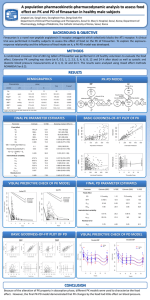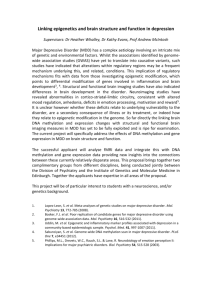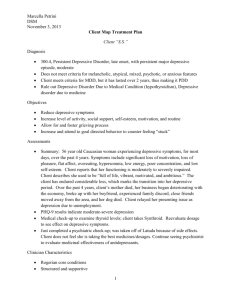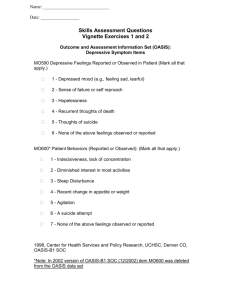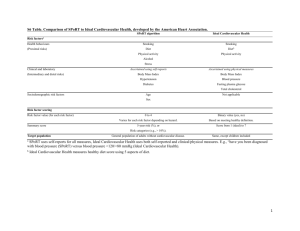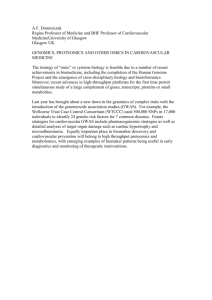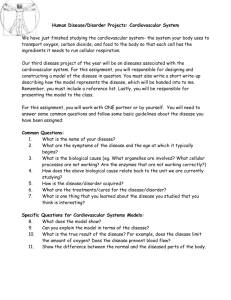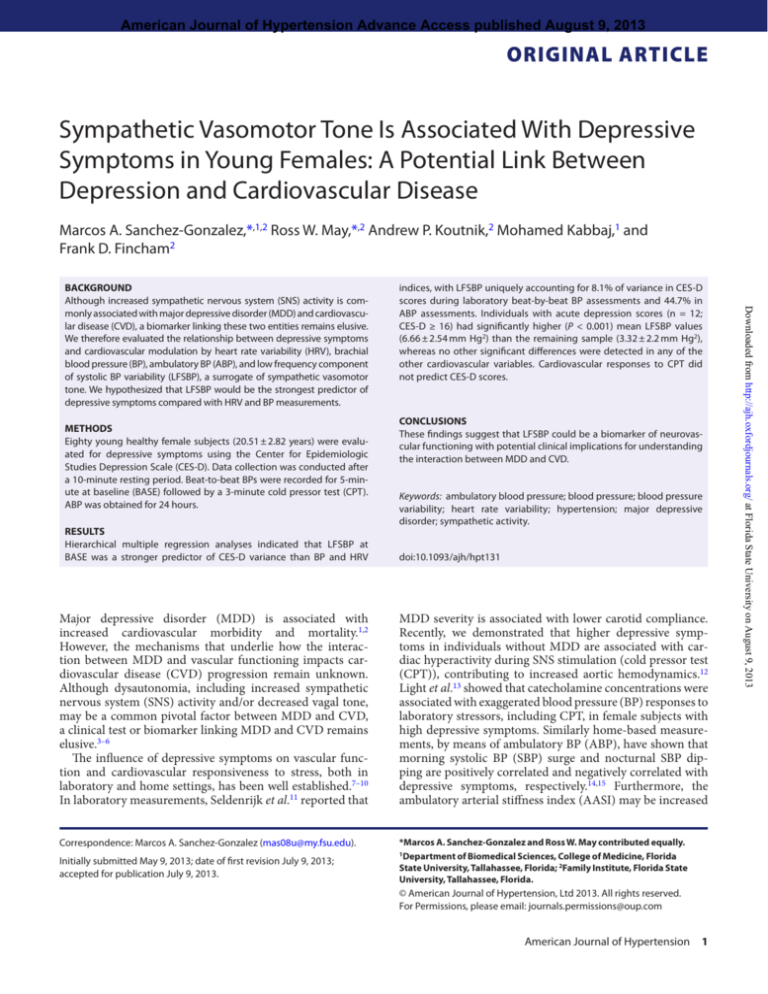
American Journal of Hypertension Advance Access published August 9, 2013
Original article
Sympathetic Vasomotor Tone Is Associated With Depressive
Symptoms in Young Females: A Potential Link Between
Depression and Cardiovascular Disease
Marcos A. Sanchez-Gonzalez,*,1,2 Ross W. May,*,2 Andrew P. Koutnik,2 Mohamed Kabbaj,1 and
Frank D. Fincham2
methods
Eighty young healthy female subjects (20.51 ± 2.82 years) were evaluated for depressive symptoms using the Center for Epidemiologic
Studies Depression Scale (CES-D). Data collection was conducted after
a 10-minute resting period. Beat-to-beat BPs were recorded for 5-minute at baseline (BASE) followed by a 3-minute cold pressor test (CPT).
ABP was obtained for 24 hours.
results
Hierarchical multiple regression analyses indicated that LFSBP at
BASE was a stronger predictor of CES-D variance than BP and HRV
indices, with LFSBP uniquely accounting for 8.1% of variance in CES-D
scores during laboratory beat-by-beat BP assessments and 44.7% in
ABP assessments. Individuals with acute depression scores (n = 12;
CES-D ≥ 16) had significantly higher (P < 0.001) mean LFSBP values
(6.66 ± 2.54 mm Hg2) than the remaining sample (3.32 ± 2.2 mm Hg2),
whereas no other significant differences were detected in any of the
other cardiovascular variables. Cardiovascular responses to CPT did
not predict CES-D scores.
conclusions
These findings suggest that LFSBP could be a biomarker of neurovascular functioning with potential clinical implications for understanding
the interaction between MDD and CVD.
Keywords: ambulatory blood pressure; blood pressure; blood pressure
variability; heart rate variability; hypertension; major depressive
disorder; sympathetic activity.
doi:10.1093/ajh/hpt131
Major depressive disorder (MDD) is associated with
in­
creased cardiovascular morbidity and mortality.1,2
However, the mechanisms that underlie how the interaction between MDD and vascular functioning impacts cardiovascular disease (CVD) progression remain unknown.
Although dysautonomia, including increased sympathetic
nervous system (SNS) activity and/or decreased vagal tone,
may be a common pivotal factor between MDD and CVD,
a clinical test or biomarker linking MDD and CVD remains
elusive.3–6
The influence of depressive symptoms on vascular function and cardiovascular responsiveness to stress, both in
laboratory and home settings, has been well established.7–10
In laboratory measurements, Seldenrijk et al.11 reported that
MDD severity is associated with lower carotid compliance.
Recently, we demonstrated that higher depressive symptoms in individuals without MDD are associated with cardiac hyperactivity during SNS stimulation (cold pressor test
(CPT)), contributing to increased aortic hemodynamics.12
Light et al.13 showed that catecholamine concentrations were
associated with exaggerated blood pressure (BP) responses to
laboratory stressors, including CPT, in female subjects with
high depressive symptoms. Similarly home-based measurements, by means of ambulatory BP (ABP), have shown that
morning systolic BP (SBP) surge and nocturnal SBP dipping are positively correlated and negatively correlated with
depressive symptoms, respectively.14,15 Furthermore, the
ambulatory arterial stiffness index (AASI) may be increased
Correspondence: Marcos A. Sanchez-Gonzalez (mas08u@my.fsu.edu).
*Marcos A. Sanchez-Gonzalez and Ross W. May contributed equally.
1Department of Biomedical Sciences, College of Medicine, Florida
State University, Tallahassee, Florida; 2Family Institute, Florida State
University, Tallahassee, Florida.
Initially submitted May 9, 2013; date of first revision July 9, 2013;
accepted for publication July 9, 2013.
© American Journal of Hypertension, Ltd 2013. All rights reserved.
For Permissions, please email: journals.permissions@oup.com
American Journal of Hypertension 1
Downloaded from http://ajh.oxfordjournals.org/ at Florida State University on August 9, 2013
background
Although increased sympathetic nervous system (SNS) activity is commonly associated with major depressive disorder (MDD) and cardiovascular disease (CVD), a biomarker linking these two entities remains elusive.
We therefore evaluated the relationship between depressive symptoms
and cardiovascular modulation by heart rate variability (HRV), brachial
blood pressure (BP), ambulatory BP (ABP), and low frequency component
of systolic BP variability (LFSBP), a surrogate of sympathetic vasomotor
tone. We hypothesized that LFSBP would be the strongest predictor of
depressive symptoms compared with HRV and BP measurements.
Sanchez-Gonzalez et al.
METHODS
Study subjects
Eighty apparently healthy, young adult, female undergraduates (aged 19–31 years of age) participated in this
study. Participants were excluded from the study if they had
hypertension (BP ≥140/90 mm Hg), chronic diseases, and/
or were taking medications (e.g., beta blockers, antidepressants, and stimulants) that could affect the cardiovascular
variables. Participants were asked to abstain from caffeine,
alcohol, and strenuous physical activity for at least 24 hours
before testing. Participants were tested in the early follicular
phase of the menstrual cycle to avoid potential variations in
pressure wave morphology and cardiac reactivity. All participants were recruited from a university sample and gave
their written consent before the experiments as approved by
the Florida State University Institutional Review Board.
2 American Journal of Hypertension
Study design and experimental protocol
Participants were first introduced to the study procedures
and familiarized with the laboratory setting. Height, weight,
waist, arm circumference, and finger circumference were
then measured, and participants filled out a health questionnaire indicating their physical health history and depressive
symptomatology.
Data collection was conducted in the morning after at least
a 10-hour postprandial period at the same time of the day
(±2 hours) to minimize potential diurnal variations in vascular reactivity. To test cardiac reactivity, we used the CPT as a
stressor because it evokes SNS stimulation, increases hemodynamics, and increases LFSBP.32–34 Participants were seated,
and then given a 10-minute rest period in a quiet, dimmedlight, and temperature-controlled room (23 ± 1 ºC). Within 5
minutes after the rest period, brachial BP was measured and
used to calibrate beat-by-beat finger BP waveforms to obtain
hemodynamic variables during a 5-minute baseline (BASE)
period. Immediately after the BASE measurements, participants completed the CPT by submerging their hand in cold
water (4 ºC) for 3 minutes. During the CPT, a researcher made
sure the participant kept their hand in the water, to wrist level,
throughout the entire task. Beat-by-beat BP was continuously
obtained for 8 minutes (5 minutes BASE and 3 minutes CPT).
We did not control breathing frequency (12–14 rsp/min)
throughout the test because it has been shown to be similar
to spontaneous breathing in healthy volunteers35 for HRV and
LFSBP determinations. In addition, controlling breathing frequency may impose an additional stress to the participants.36
Participants were then fitted with an ABP monitoring
device. The unit was calibrated to take 4 measurements
per hour for 24 hours (resulting in 96 assessments) of SBP,
diastolic BP (DBP), and HR. The ABP setup and monitoring began between 9 and 11 am and concluded with the
ABP monitor being returned to the laboratory the following
day. Participants were instructed to keep the ABP cuff on
throughout the entire 24 hours.
Depression scale
Depression was measured the same day the participant
came into the lab using the 10-item Center for Epidemiologic
Studies Depression Scale (CES-D).37,38 The CES-D has
been widely used as a stable measure of chronic depressive
symptoms.39,40 Responses were summed into 1 overall
score, with a possible range of 0–30. Prior studies involving
the longer 20-item version of this scale have used a rough
estimate of the top quintile of scores to define participants
as “depressed,” and a validation study found that a score ≥16
has 99% sensitivity to identifying acute depression.39,40
Cardiovascular measurements
Beat-by-beat BP. Brachial SBP was used to calibrate
beat-by-beat BP, which was recorded for an 8-minute period
by finger plethysmography (NIBP-100 Biopac, Goleta, CA).
This method is validated and has been shown to provide
accurate measurement of BP changes when compared with
intra-arterial BP.41
Downloaded from http://ajh.oxfordjournals.org/ at Florida State University on August 9, 2013
in patients with MDD, owing to increased arterial stiffness
and potentially increased SNS activity.16,17 Together these
studies suggest that MDD has a profound impact on the vasculature, most likely to be mediated by increased SNS tone,
and hence markers of neurovascular modulation may better
demonstrate the association between MDD and CVD.
Power spectral analysis of heart rate (HR) variability
(HRV), measured in time and/or frequency domains, has
been used for evaluating cardiac autonomic regulation in
patients with mood disorders and CVD.18–21 Patients with
MDD have been shown to have lower HRV, suggesting
reduced cardiovagal modulation and increased SNS activity.22–25 Because increased sympatho-vagal tone increases
cardiac risk, the association between decreased HRV and
MDD seems to predispose psychiatric patients to adverse
cardiac events such as myocardial infarction, arrhythmias,
and sudden cardiac arrest.4,23,26 Together these studies suggest that MDD decreases cardiac parasympathetic nervous
system (PNS) activity rather than affecting SNS tone, especially at the subclinical level. This may be expected because
of the greater influence of vagal tone over SNS flow on HR
modulation.21,27 However, vascular autonomic modulation is known to have a predominant SNS tone,28–30 hence
the evaluation of the rhythmical oscillations in SBP in the
low-frequency domain (LFSBP), a surrogate of sympathetic
vasomotor tone,31 may be more appropriate for understanding the influence of SNS hyperactivity on vascular function
in MDD. Although several studies have shown a robust association between vascular dysfunction and MDD, the association between LFSBP and depressive symptoms has not been
explored.
Because MDD is known to result in SNS hyperactivity and
impaired vascular functioning, it is reasonable to explore
LFSBP as a potential biomarker of cardiovascular functioning in healthy individuals that vary in depressive symptoms.
Because females have higher prevalence rates of MDD than
males,2 this study evaluated sympathetic vasomotor tone at
rest and during SNS stimulation in healthy young females.
We tested the hypothesis that LFSBP would be a stronger
predictor of depressive symptoms than laboratory brachial
BP, time and frequency domain measures of HRV, and ABP.
Depression and Sympathetic Vasomotor Tone
BP variability. The SBP time series was resampled at 5
Hz, and the continuous data stream passed through a low
pass impulse response filter with a cutoff frequency of 0.5 Hz.
The data were then subjected to Fast Fourier transform algorithms using a Hanning spectral window and subsequently
smoothed using a triangular averaging function to produce
a spectrum. The power was calculated by measuring the area
under the peak of the power spectra density curve. Power
spectra within the 0.04–0.15 Hz range were defined as LFSBP
and taken as an estimate of sympathetic vasomotor modulation.31 In our laboratory, the intraclass correlation coefficients for resting SBP, DBP, LFSBP, nLF, and nHF taken on 2
separate days were 0.97, 0.97, 0.95, 0.94, and 0.94 respectively.
Ambulatory BP. The ABP measurements were obtained
for 24 hours using a validated oscillometric 90217A
SpaceLabs BP monitor (Spacelabs, Wokingham, Berkshire,
UK). To calculate the ambulatory arterial stiffness index
(AASI), the regression slope of ambulatory diastolic BP
(ADBP) on ambulatory SBP (ASBP) from unedited 24 hour
recordings, taken at a rate of 4 per hour, were computed for
each participant. The ASBP dipping (ASBP-D) and ADBP
dipping (ADBP-D) were obtained using the SpaceLabs analysis software. AASI was defined as 1 minus the regression
slope. The stiffer the arterial tree, the closer the regression
slope and AASI are to 0 and 1, respectively.43
Statistics
Shapiro–Wilk normality tests were used for absolute values for all HRV variables. Results indicated TP, pNN50, and
RMSSD to be nonnormally distributed; therefore a logarithmic transformation (Ln) was performed for these variables. Hierarchical multiple regression (HMR) analyses were
conducted to test the association between CES-D scores and
cardiovascular parameters and to demonstrate the incremental contribution of sets of predictors in accounting of CES-D
variance. Two laboratory and 1 ambulatory HMR analyses
were conducted. The first laboratory HMR analysis contained
3 sets of predictors: Model 1 contained the hemodynamic
indices (SBP, DBP); model 2 contained the HRV indices (HR,
LnTP, LnpNN50, LnRMSSD, nLF, nHF); and model 3 contained the LFSBP. To evaluate cardiovascular changes from
BASE to CPT, paired sample t tests were conducted. Studen
t tests were used to evaluate the differences in cardiovascular parameters at rest between acutely depressed (CES-D
≥ 16) and healthy control subjects. Additionally, difference
scores were created (CPT-BASE values) for SBP, DBP, HR,
nLF, nHF, and LFSBP. The difference scores were then used
as CES-D predictors in a second laboratory HRM analysis.
Difference scores for LnTP, LnpNN50, and LnRMSSD were
not calculated because of potential confounding results of the
nonsteady state condition of the CPT. For this HRM analysis,
model 1 contained the hemodynamic indices (∆SBP, ∆DBP),
model 2 contained the HRV indices (∆HR, ∆nLF, ∆nHF) and
model 3 contained the ∆LFSBP. The ambulatory HRM analysis contained 3 sets of predictors: model 1 contained the averaged 24-hour SBP, DBP, and HR values plus the AASI index;
model 2 contained the average SBP and DBP dipping values;
and model 3 contained the laboratory-assessed LFSBP values.
RESULTS
Demographics
No correlations were significant between CES-D
scores and any physical characteristic (mean ± SD:
height = 1.61 ± 0.62 m; weight = 63.54 ± 13.70 kg, and body
mass index = 24.23 ± 3.50 kg/m2). Ethnic composition of the
sample was 73% white, 11% black, 10% Asian, and 6% were
either biracial or nondisclosed ethnicity. Multinomial logistic
regression analyses indicated that CES-D scores were not
associated with ethnicity ( χ 2 (4) = 3.17; P = 0.53). These
analyses warrant the exclusion of demographics in further
CES-D analyses. CES-D scores indicated that 12 individuals
met qualification for acute depression.
Laboratory analyses
HMR analysis indicated that model 1 predictors accounted
for 13.8% of the variance in reported CES-D scores (F(2,
77) = 6.18; P = 0.003). The addition of model 2 predictors
accounted for a nonsignificant additional 13.2% of the variance in CES-D scores (∆F(6, 71) = 2.15; P = 0.06). The addition of LFSBP in model 3 accounted for an additional 8.1% of
variance (∆F(1, 70) = 8.80; P = 0.004). LFSBP had a positive
relationship with CES-D scores and was the only significant
predictor in the full model (see Table 1). Figure 1 displays
the regression of CES-D scores on laboratory LFSBP values.
In comparing BASE cardiovascular indices, Student t tests
indicated that individuals qualifying with acute depression
scores (CES-D ≥ 16) had significantly higher mean LFSBP
scores than the remaining sample (t(78) = 4.75; P < 0.001;
Cohen’s d = 1.40) (see Table 3).
American Journal of Hypertension 3
Downloaded from http://ajh.oxfordjournals.org/ at Florida State University on August 9, 2013
HR variability. The BP peaks were used to calculate the
time duration of intervals between heartbeats (RRI) and were
automatically detected using commercially available software (WinCPRS, Turku, Finland). The RRI were inspected
for artifacts, premature beats, and ectopic episodes to calculate HRV parameters. The HRV was calculated through the
time domain statistics percentage of adjacent R–R intervals
that differ by 50 ms (pNN50), root mean square of successive
R–R differences (RMSSD), and total power (TP) or variance
in RRI. These are considered markers of cardiac vagal modulation,19 and the TP of HRV is an estimation of the global
activity of the autonomic nervous system.29 The main spectral components of the HRV that we calculated, by means
of Fast Fourier transformation, were the low frequency (LF;
0.04–0.15 Hz) and the high frequency (HF; 0.15–0.4 Hz). HF
is a marker of cardiac PNS activity.29 The LF component of
HRV is mediated by both SNS and PNS activities19 and may
also represent baroreflex function.42 Alternatively, the use of
absolute units (ms2) for HF and LF may be obtained in proportion to the TP, which is expressed in normalized units
(nu). Normalization is used to exclude the influence of other
fractal components and to control for the changes in TP;
hence it is more appropriate to report LF and HF responses
to stress in normalized units.19
nHF
LFSBP (mmHg2)
0.29
−0.10
0.37
−0.50
0.18
−0.11
0.34
LnRMSSD (ms2)
0.09
−0.11
0.14
0.07
0.09
−0.10
−0.55
0.15
nLF
−0.20
LnTP
0.24
HR (bpm)
LnpNN50 (ms2)
0.09
DBP (mmHg)
(ms2)
0.12
−0.50
SBP (mmHg)
nHF
−0.09
0.25
0.06
−0.14
0.18
0.04
0.29
0.10
0.29
sr
0.004
0.298
0.242
0.062
0.333
0.268
0.157
0.470
0.364
0.323
0.368
0.016
0.558
0.173
0.078
0.691
0.005
0.359
0.008
p
∆LFSBP (mmHg2)
∆nHF
∆nLF
∆HR (bpm)
∆DBP (mmHg)
∆SBP (mmHg)
∆nHF
∆nLF
∆HR (bpm)
∆DBP (mmHg)
∆SBP (mmHg)
∆DBP (mmHg)
∆SBP (mmHg)
Predictor
−0.41
0.51
0.16
−0.21
−0.61
0.38
0.35
0.37
0.01
0.10
−0.19
0.12
−0.09
β
−0.15
0.09
0.04
−0.06
−0.14
0.07
0.26
0.26
0.01
0.07
−0.14
0.09
−0.07
sr
0.211
0.453
0.774
0.640
0.240
0.551
0.110
0.111
0.972
0.646
0.384
0.563
0.638
p
−0.12
0.06
−0.18
−0.14
ADBP (mmHg)
AHR (bpm)
−0.11
0.05
−0.14
−0.13
ADBP (mmHg)
AHR (bpm)
−0.08
−0.36
0.14
0.36
−0.09
ASBP (mmHg)
ADBP (mmHg)
AHR (bpm)
0.95
−0.35
ADBP-D (%)
LFSBP(mmHg2)
0.31
ASBP-D (%)
ASSI
0.29
0.00
ADBP-D (%)
0.67
−0.20
0.20
0.07
−0.16
0.00
0.13
0.06
0.21
ASSI
ASBP-D (%)
−0.07
0.29
0.06
0.50
ASSI
ASBP (mmHg)
−0.10
0.25
0.45
ASBP (mmHg)
sr
β
Predictor
ABP (n = 58)
<0.001
0.093
0.081
0.487
0.014
0.525
0.180
0.999
0.422
0.754
0.525
0.660
0.089
0.722
0.481
0.541
0.125
p
Models parameter estimates.
Abbreviations: ABP, ambulatory blood pressure; ADBP, ambulatory diastolic blood pressure; ADBP-D, ambulatory diastolic blood pressure dipping; AHR, ambulatory heart rate; ASBP,
ambulatory systolic blood pressure; ASBP-D, ambulatory systolic blood pressure dipping; ASSI, ambulatory arterial stiffness index; BASE, baseline; CPT, cold pressor test; DBP, diastolic
blood pressure; HR, heart rate; LnpNN50; LFSBP, low frequency systolic blood pressure; Ln percentage of adjacent R-R intervals that differ by 50 ms; LnRMSSD, Ln root mean square of
successive R–R differences; LnTP, Ln Total Power; sr, semipartial correlation; nHF, normalized high frequency; nLF, normalized low frequency; SBP, systolic blood pressure.
Model 3
0.44
LnRMSSD (ms2)
−0.44
0.09
nLF
−0.23
LnTP
0.31
HR (bpm)
LnpNN50 (ms2)
0.05
DBP (mmHg)
(ms2)
0.33
0.11
DBP (mmHg)
SBP (mmHg)
0.32
SBP (mmHg)
β
CPT (n = 80)
Downloaded from http://ajh.oxfordjournals.org/ at Florida State University on August 9, 2013
4 American Journal of Hypertension
Model 2
Model 1
Predictor
BASE (n = 80)
Table 1. Parameter estimates of cardiovascular predictors of Center for Epidemiologic Studies Depression Scale for baseline, cold pressor test, and ambulatory assessment
Sanchez-Gonzalez et al.
Depression and Sympathetic Vasomotor Tone
ABP analyses
Paired sample t tests comparing CPT to BASE changes
indicated all cardiovascular variables, except LFSBP, significantly changed in the expected directions, with increases
in SBP, DBP, HR, LnTP, LnpNN50, LnRMSSD, and nLF
and a decrease in nHF (see Table 2). HMR results of
difference scores showed none of the models accounted for
a significant amount of variance in reported CES-D scores:
model 1 (model R2 = 0.017; F(2, 77) = 0.60; P = 0.55); model
2 (∆R2 = 0.022; ∆F(3, 74) = 2.15; P = 0.68); model 3 (∆R2 =
0.023; ∆F(1, 73) = 8.80; P = 0.21]. No full model predictors
of CES-D scores were significant (see Table 1).
Fifty-eight females completed the ABP measurements.
Those who did not complete this measurement had similar
baseline characteristics as those with the complete highquality measurements as compared by means of Student t
tests (Table 4). HMR results indicated model 1 predictors
accounted for a nonsignificant 15% of the variance in CES-D
scores (F(4, 53) = 1.41; P = 0.24). The addition of the model 2
predictors accounted for an additional, nonsignificant 2.6%
of the variance in CES-D scores (∆F (2, 51) = 0.48; P = 0.62).
The addition of LFSBP in model 3 significantly accounted
for an additional 44.7% of variance (∆F(1, 50) = 34.34;
P < 0.001). As shown in Table 1, although both average
24-hour HR and LFSBP in the full model were significant
CES-D predictors, calculation of 95% confidence intervals
(CIs) of final model semipartial correlations indicate LFSBP
(95% CI = 0.490–0.795) to be a significantly greater CES-D
predictor than HR (95% CI = 0.063–0.488). The ABP measurements of ASBP, ADBP, ASBP-D, ADBP-D, and ASSI
were not significant full model HMR predictors of CES-D
(Table 1) and were not different between participants with
CES-D ≥16 and CES-D <16 (Table 3).
Discussion
Figure 1. Regression of depressive scores on sympathetic vasomotor
tone. Abbreviations: CES-D, Center for Epidemiologic Studies Depression
Scale; LFSBP, low frequency component of systolic blood pressure variability.
The aim of this study was to evaluate sympathetic
vasomotor tone as a potential biomarker of cardiovascular
functioning in apparently healthy female subjects that
varied in depressive symptoms. The novel findings of
this study are the following: (i) LFSBP was a stronger
predictor of depressive symptoms than conventional
measures of cardiovascular functioning such as laboratory
measurement of BP and HRV, as well as home based ABP
monitoring; (ii) depressive symptoms are associated with
a blunted LFSBP response to CPT; and (iii) participants
with acute depression had higher LFSBP than those with
Table 2. Paired sample t tests comparing cardiovascular changes from baseline to cold pressor test (n = 80)
BASE
CPT
Variable
Mean ± SD
Mean ± SD
T
P value
SBP, mmHg
120 ± 11
125 ± 15
−3.78
<0.001
DBP, mmHg
79 ± 7
87 ± 10
−7.93
<0.001
HR, bpm
74 ± 10
82 ± 12
−5.42
<0.001
ms2
8.50 ± 1.23
9.64 ± 2.48
−3.86
<0.001
LnRMSSD, ms2
4.34 ± 0.65
5.42 ± 1.62
−6.53
<0.001
3.39 ± 0.42
3.60 ± 0.42
−4.46
<0.001
0.56 ± 0.15
0.63 ± 0.19
−3.64
<0.001
nHF
0.40 ± 0.13
0.32 ± 0.18
4.78
<0.001
LFSBP, mmHg2
3.89 ± 3.15
3.80 ± 4.09
0.21
0.84
LnTP,
LnpNN50,
ms2
nLF
Abbreviations: BASE, baseline; CPT, cold pressor test; DBP, diastolic blood pressure; HR, heart rate; LFSBP, low frequency component of
systolic blood pressure variability; LnPNN50, Ln time domain statistics percentage of adjacent R-R intervals that differ by 50 ms; LnRMSSD, Ln
root mean square of successive R-R differences; LnTP, Ln Total Power; SBP, systolic blood pressure; nHF, normalized high frequency of heart
rate varibility; nLF, normalized low frequency of heart rate varibility.
American Journal of Hypertension 5
Downloaded from http://ajh.oxfordjournals.org/ at Florida State University on August 9, 2013
CPT difference score analyses
Sanchez-Gonzalez et al.
Table 3. Student t test comparing cardiovascular parameters between acutely depressed and healthy control subjects
CES-D < 16
CES-D ≥16
Variable
No.
Mean ± SD
No.
Mean ± SD
t
P value
SBP, mmHg
68
118 ± 11
12
124 ± 13
−1.71
0.09
DBP, mmHg
68
79 ± 8
12
81 ± 4
−0.91
0.37
HR, bpm
68
78 ± 9
12
82 ± 11
−1.27
0.21
LnTP, ms2
68
8.52 ± 1.21
12
8.46 ± 1.48
0.15
0.88
LnRMSSD, ms2
68
4.32 ± 0.61
12
4.59 ± 1.13
−1.24
0.22
LnpNN50, ms2
68
3.40 ± 0.42
12
3.27 ± 0.38
1.06
0.29
nLF
68
0.57 ± 0.12
12
0.52 ± 0.24
1.20
0.23
nHF
68
0.39 ± 0.11
12
0.43 ± 0.21
−0.89
0.38
68
3.32 ± 2.21
LFSBP,
mmHg2
6.66 ± 2.54
−4.75
<0.001
46
114 ± 8
12
117 ± 10
−1.36
0.18
ADBP, mmHg
46
71 ± 6
12
71 ± 5
0.05
0.96
AHR, bpm
46
79 ± 8
12
79 ± 9
−0.11
0.83
ASSI
46
0.28 ± 0.16
12
0.35 ± 0.21
−1.11
0.27
ASBP-D, %
46
4.49 ± 6.11
12
3.10 ± 6.62
0.61
0.54
ADBP-D, %
46
7.14 ± 9.34
12
6.35 ± 11.82
0.99
0.33
Abbreviations: ADBP, ambulatory diastolic blood pressure; ADBP-D, ambulatory diastolic blood pressure dipping; AHR, ambulatory heart
rate; ASBP, ambulatory systolic blood pressure; ASBP-D, ambulatory systolic blood pressure dipping; ASSI, ambulatory arterial stiffness index;
BASE, baseline; CES-D, Center for Epidemiologic Studies Depression Scale; CPT, cold pressor test; DBP, diastolic blood pressure; HR, heart
rate; LFSBP, low frequency component of systolic blood pressure variability; LnpNN50, Ln percentage of adjacent R-R intervals that differ by
50 ms; LnRMSSD, Ln root mean square of successive R-R differences; LnTP, Ln Total Power; nHF, normalized high frequency of heart rate
varibility; nLF, normalized low frequency component of heart rate variability; SBP, systolic blood pressure.
Table 4. Student t test comparing cardiovascular parameters between participants with and without ambulatory blood pressure
measurements
With ABP
Without ABP
Variable
No.
Mean ± SD
No.
Mean ± SD
t
P value
SBP, mmHg
58
121 ± 13
22
117 ± 10
−1.69
0.10
DBP, mmHg
58
79 ± 8
22
79 ± 4
0.11
0.92
HR, bpm
58
80 ± 9
22
77 ± 10
−1.45
0.15
LnTP, ms2
58
8.46 ± 1.32
22
8.54 ± 1.19
0.32
0.75
LnRMSSD,
58
4.32 ± 0.65
22
4.40 ± 0.75
0.58
0.57
LnpNN50, ms2
58
3.35 ± 0.42
22
3.42 ± 0.41
1.08
0.28
nLF
58
0.58 ± 0.14
22
0.54 ± 0.15
−1.57
0.12
nHF
58
0.37 ± 0.12
22
0.42 ± 0.13
1.67
0.10
58
3.92 ± 3.21
22
3.75 ± 2.43
−0.27
0.79
LFSBP,
ms2
mmHg2
Abbreviations: ABP, ambulatory blood pressure; DBP, diastolic blood pressure; HR, heart rate; LFSBP, low frequency component of systolic
blood pressure variability; LnpNN50, Ln percentage of adjacent R-R intervals that differ by 50 ms; LnRMSSD, Ln root mean square of successive R-R differences; LnTP, Ln Total Power; nHF, normalized high frequency of heart rate varibility; nLF, normalized low frequency component
of heart rate variability; SBP, systolic blood pressure.
normal depressive scores without any clinically significant
alterations in brachial BP, HRV (time and frequency
domains), ABP, and AASI. Our data suggest that in females
apparently free of CVD, high depressive symptoms are
associated with increased sympathetic vasomotor tone and,
to some extent, an early manifestation of dysautonomia.
Therefore, LFSBP could be a reasonable biomarker with
6 American Journal of Hypertension
potential clinical applications for the diagnosis of MDD
and its associated CVD risk.
Recently, the use of biomarkers for diagnosing and evaluating therapeutic effectiveness in patients with MDD has
been explored. Some studies have suggested novel serum
biomarkers for detecting individuals at increased risk of
MDD in addition to noninvasive measures for evaluating
Downloaded from http://ajh.oxfordjournals.org/ at Florida State University on August 9, 2013
12
ASBP, mmHg
Depression and Sympathetic Vasomotor Tone
MDD may evoke endothelial dysfunction and damage as a
result of the complex interaction between SNS activity and
nitric oxide production.61,62 Together, the results of previous
studies and our data suggest that increased sympathetic vasomotor tone may be a pivotal physiological alteration associated with depressive symptoms and may ultimately promote
cardiovascular damaging and subclinical CVD.
Potential limitations of this study include a limited sample size; inclusion of only female participants; and lack of
autonomic function serum markers, including catecholamines and cortisol as well as 24-hour HRV. In addition, cardiovascular responses during the recovery period after SNS
stimulation were not evaluated. In this study, we did not
evaluate aortic pulse wave velocity, a gold-standard measure for arterial stiffness and a strong cardiovascular risk
factor, or direct measures of SNS such as muscle SNS activity. We did not measure sleep quality in this study, which
may influence autonomic function. However, the selected
scale of CES-D has questions regarding sleep quality. Our
statistical model did not control for anxiety and/or physical
activity. Finally, our sample comprised young adult females
who were not clinically diagnosed as suffering from MDD;
hence we may not generalize our results to other populations. However, the study was designed to evaluate potential
markers of cardiovascular functioning in a population susceptible to MDD.
These results indicate that LFSBP is a strong predictor of
depressive symptoms in healthy females without clinically
diagnosed MDD in the absence of clinically significant
alterations in BP, ABP, and HRV. Although MDD may be
associated with cardiac hyperactivity during SNS stimulation,
we found an association of blunted LFSBP response with
depressive scores, suggesting dysautonomia. The findings
of this study point toward the conclusion that LFSBP may
be a feasible biomarker of neurovascular functioning
with potential clinical implications for understanding the
interaction between MDD and CVD. Prospective studies
intended to confirm whether LFSBP may indicate a higher
cardiovascular risk and/or early manifestations of CVD in
individuals with high depressive scores are warranted.
Acknowledgments
We thank Mr. Preston C. Brown for his assistance in
subject recruitment and data acquisition.
DISCLOSURE
The authors declare no conflicts of interest.
References
1. Rozanski A, Blumenthal JA, Kaplan J. Impact of psychological factors
on the pathogenesis of cardiovascular disease and implications for
therapy. Circulation 1999; 99:2192–2217.
American Journal of Hypertension 7
Downloaded from http://ajh.oxfordjournals.org/ at Florida State University on August 9, 2013
psychological status.44–47 Nevertheless, an easily obtained
noninvasive biomarker that may be indicative of cardiovascular alterations in healthy and MDD patients remains elusive. Previous research, using laboratory and/or home-based
cardiovascular measurements, has shown that depressive
symptoms contribute to cardiovascular functioning impairments in addition to increased CVD risk in both healthy
and clinical populations.1,6,12,25,48 In home-based ABP measurements, prior studies have shown associations between
depressive symptoms and nocturnal SBP.14 Here we did not
find associations between ABP, AASI, and depressive symptoms, suggesting a potential limitation of ABP for detecting
CVD risk in healthy young females with higher depressive
symptoms. In laboratory measurements, during SNS stimulation, we and others have shown an association between
depressive symptoms and increased brachial BP, aortic BP,
and blood catecholamine concentration.12,13,49,50 In addition, Gordon et al.51 and Solomon et al.52 documented that
after SNS stimulation depressive symptoms were associated with attenuated HR recovery or impaired cardiovagal
reactivation. In this study, we observed that LFSBP was the
strongest predictor of depressive symptoms at rest, in comparison with time and frequency domains of HRV, brachial
SBP, brachial DBP, and ABP. We identified 12 participants
with acute depression (CES-D ≥ 16) that displayed a 2-fold
increase in LFSBP at rest compared with those with normal
depressive scores. Furthermore, a blunted LFSBP response
during CPT was associated with higher depressive symptoms, which may be indicative of dysautomia in view of the
fact that blunted cardiac and LFSBP responses to stress have
been documented in MDD and autonomic failure patients,
respectively.4,52–54 Our data demonstrate that depressive
symptoms are associated with dysautonomia and increased
sympathetic vasomotor tone, even in the absence of clinically meaningful cardiovascular alterations, suggesting that
LFSBP could be an early indicator of increased cardiovascular risk in females with high depressive scores.
Although it is unclear how depressive symptoms evoke
SNS hyperactivity and attenuated PNS activity, dysautonomia seems to be a common pathway, and it may represent
a common manifestation in the development of MDD and
CVD.18,55–57 Moreover, MDD is commonly associated with
dysautonomia, reflected as increased sympathovagal tone,
which may be a pivotal process in the development of cardiovascular complications such as arrhythmias, hypertension, arterial stiffening, and atherosclerosis.4,11 Currently,
the impact of depressive symptoms and LFSBP on vascular
function is not well understood. However, increased vasomotor tone may lead to vascular dysfunction and endothelial damage, which are pivotal factors in the development of
CVD.58–60 Chen et al.61 demonstrated that, in healthy subjects without significant CVD, high depressive scores were
associated with impaired brachial flow, medicated vasodilation, and depletion of circulating endothelial progenitor
cells, suggesting endothelial dysfunction and remodeling.
It could be that the associated depressive state with SNS
hyperactivity may promote an atherosclerotic environment
and inflammation affecting the endothelial cells. Because we
observed that high depressive symptoms are associated with
increased LFSBP, our main finding adds to the notion that
Sanchez-Gonzalez et al.
8 American Journal of Hypertension
community-residing persons without coronary heart disease. Eur J Prev
Cardiol 2012. In press.
24. Yeragani VK, Pohl R, Balon R, Ramesh C, Glitz D, Jung I, Sherwood P.
Heart rate variability in patients with major depression. Psychiatry Res
1991; 37:35–46.
25. Bajko Z, Szekeres CC, Kovacs KR, Csapo K, Molnar S, Soltesz P, Nyitrai
E, Magyar MT, Olah L, Bereczki D, Csiba L. Anxiety, depression and
autonomic nervous system dysfunction in hypertension. J Neurol Sci
2012; 317:112–116.
26. Tsuji H, Larson MG, Venditti FJ, Jr., Manders ES, Evans JC, Feldman
CL, Levy D. Impact of reduced heart rate variability on risk for cardiac
events. The Framingham Heart Study. Circulation 1996; 94:2850–2855.
27. Iellamo F, Pizzinelli P, Massaro M, Raimondi G, Peruzzi G, Legramante
JM. Muscle metaboreflex contribution to sinus node regulation during
static exercise: insights from spectral analysis of heart rate variability.
Circulation 1999; 100:27–32.
28. Floras JS, Hara K. Sympathoneural and haemodynamic characteristics
of young subjects with mild essential hypertension. J Hypertens 1993;
11:647–655.
29. Pagani M, Lombardi F, Guzzetti S, Rimoldi O, Furlan R, Pizzinelli P,
Sandrone G, Malfatto G, Dell’Orto S, Piccaluga E, Turiel M, Baselli G,
Cerutti S, Malliani A. Power spectral analysis of heart rate and arterial
pressure variabilities as a marker of sympatho-vagal interaction in man
and conscious dog. Circ Res 1986; 59:178–193.
30.Julien C, Malpas SC, Stauss HM. Sympathetic modulation of blood
pressure variability. J Hypertens 2001; 19:1707–1712.
31.Malliani A, Pagani M, Lombardi F, Cerutti S. Cardiovascular neural regulation explored in the frequency domain. Circulation 1991;
84:482–492.
32. Koch DW, Leuenberger UA, Proctor DN. Augmented leg vasoconstriction in dynamically exercising older men during acute sympathetic
stimulation. J Physiol 2003; 551:337–344.
33. Casey DP, Braith RW, Pierce GL. Changes in central artery blood pressure and wave reflection during a cold pressor test in young adults. Eur
J Appl Physiol 2008; 103:539–543.
34.Wecht JM, Weir JP, DeMeersman RE, Schilero GJ, Handrakis JP,
LaFountaine MF, Cirnigliaro CM, Kirshblum SC, Bauman WA. Cold
face test in persons with spinal cord injury: age versus inactivity. Clin
Auton Res 2009; 19:221–229.
35. Song HS, Lehrer PM. The effects of specific respiratory rates on heart
rate and heart rate variability. Appl Psychophysiol Biofeedback 2003;
28:13–23.
36. Madden K, Savard GK. Effects of mental state on heart rate and blood
pressure variability in men and women. Clin Physiol 1995; 15:557–569.
37. Radloff LS. The CES-D Scale. Appl Psycholog Measure 1977; 1:385–401.
38. Santor DA, Coyne JC. Shortening the CES–D to improve its ability to
detect cases of depression. PsychologAssess 1977; 9:233–243.
39. Weissman MM, Sholomskas D, Pottenger M, Prusoff BA, Locke BZ.
Assessing depressive symptoms in five psychiatric populations: a
validation study. Am J Epidemiol 1977; 106:203–214.
40.Anda RF, Williamson DF, Escobedo LG, Mast EE, Giovino GA,
Remington PL. Depression and the dynamics of smoking. A national
perspective. JAMA 1990; 264:1541–1545.
41.Imholz BP, Wieling W, Langewouters GJ, van Montfrans GA.
Continuous finger arterial pressure: utility in the cardiovascular laboratory. Clin Auton Res 1991; 1:43–53.
42. Rahman F, Pechnik S, Gross D, Sewell L, Goldstein DS. Low frequency
power of heart rate variability reflects baroreflex function, not cardiac
sympathetic innervation. Clin Auton Res 2011; 21:133–141.
43. Adiyaman A, Dechering DG, Boggia J, Li Y, Hansen TW, Kikuya M,
Bjorklund-Bodegard K, Richart T, Thijs L, Torp-Pedersen C, Ohkubo T,
Dolan E, Imai Y, Sandoya E, Ibsen H, Wang J, Lind L, O’Brien E, Thien
T, Staessen JA. Determinants of the ambulatory arterial stiffness index
in 7604 subjects from 6 populations. Hypertension 2008; 52:1038–1044.
44. Zarate CA, Jr., Mathews DC, Furey ML. Human biomarkers of rapid
antidepressant effects. Biol Psychiatry 2013; 73(12):1142–1155.
45. Schneider B, Prvulovic D. Novel biomarkers in major depression. Curr
Opin Psychiatry 2012; 26:47–53.
46. Hepgul N, Cattaneo A, Zunszain PA, Pariante CM. Depression pathogenesis and treatment: what can we learn from blood mRNA expression? BMC Med 2013; 11:28.
47.Milanesi E, Minelli A, Cattane N, Cattaneo A, Mora C, Barbon A,
Mallei A, Popoli M, Florio V, Conca A, Bignotti S, Gennarelli M. ErbB3
Downloaded from http://ajh.oxfordjournals.org/ at Florida State University on August 9, 2013
2. Niranjan A, Corujo A, Ziegelstein RC, Nwulia E. Depression and heart
disease in US adults. Gen Hosp Psychiatry 2012; 34:254–261.
3. Hamer M, Malan L. Sympathetic nervous activity, depressive symptoms, and metabolic syndrome in black Africans: the sympathetic
activity and ambulatory blood pressure in Africans study. Stress 2012;
15:562–568.
4.Koschke M, Boettger MK, Schulz S, Berger S, Terhaar J, Voss A,
Yeragani VK, Bar KJ. Autonomy of autonomic dysfunction in major
depression. Psychosom Med 2009; 71:852–860.
5.Shinba T, Kariya N, Matsui Y, Ozawa N, Matsuda Y, Yamamoto K.
Decrease in heart rate variability response to task is related to anxiety
and depressiveness in normal subjects. Psychiatry Clin Neurosci 2008;
62:603–609.
6.Hughes JW, York KM, Li Q, Freedland KE, Carney RM, Sheps DS.
Depressive symptoms predict heart rate recovery after exercise treadmill testing in patients with coronary artery disease: results from the
Psychophysiological Investigation of Myocardial Ischemia study.
Psychosom Med 2008; 70:456–460.
7. Dietz LJ, Matthews KA. Depressive symptoms and subclinical markers of cardiovascular disease in adolescents. J Adolesc Health 2011;
48:579–584.
8.Hamer M, Frasure-Smith N, Lesperance F, Harvey BH, Malan NT,
Malan L. Depressive symptoms and 24-hour ambulatory blood pressure in Africans: the SABPA study. Int J Hypertens 2012; 2012:426803.
9. Nemeroff CB, Goldschmidt-Clermont PJ. Heartache and heartbreakthe link between depression and cardiovascular disease. Nat Rev
Cardiol 2012; 26:526–539.
10. Scuteri A, Castello L, Coluccia R, Modestino A, Nevola E, Volpe M.
Depression is associated with increased occurrence of left ventricle
concentric geometry in older subjects independently of blood pressure
levels. Nutr Metab Cardiovasc Dis 2011; 21:915–921.
11.Seldenrijk A, van Hout HP, van Marwijk HW, de Groot E, Gort J,
Rustemeijer C, Diamant M, Penninx BW. Depression, anxiety, and arterial stiffness. Biol Psychiatry 2011; 69:795–803.
12. Sanchez-Gonzalez MA, May RW, Brown PC, Koutnik AP, Fincham FD.
Depressive symptoms contribute to increased wave reflection during
cold pressor test in young adult men. Am J Hypertens 2013; 26:778–783.
13. Light KC, Kothandapani RV, Allen MT. Enhanced cardiovascular and
catecholamine responses in women with depressive symptoms. Int J
Psychophysiol 1998; 28:157–166.
14. Scuteri A, Spalletta G, Cangelosi M, Gianni W, Assisi A, Brancati AM,
Modestino A, Caltagirone C, Volpe M. Decreased nocturnal systolic
blood pressure fall in older subjects with depression. Aging Clin Exp
Res 2009; 21:292–297.
15. FitzGerald L, Ottaviani C, Goldstein IB, Shapiro D. Effects of dipping
and psychological traits on morning surge in blood pressure in healthy
people. J Hum Hypertens 2012; 26:228–235.
16. Li Y, Wang JG, Dolan E, Gao PJ, Guo HF, Nawrot T, Stanton AV, Zhu
DL, O’Brien E, Staessen JA. Ambulatory arterial stiffness index derived
from 24-hour ambulatory blood pressure monitoring. Hypertension
2006; 47:359–364.
17. Wang MY, Huang CJ, Wu YL, Liu JC, Tsai PS. The influence of baroreflex sensitivity on ambulatory arterial stiffness index in individuals with
cardiovascular risk. Blood Press Monit 2010; 15:262–267.
18. Malliani A, Pagani M, Lombardi F. Neurovegetative regulation and cardiovascular diseases. Ann Ital Med Int 1991; 6:460–469.
19.Anon. Heart rate variability: standards of measurement, physi
ological interpretation and clinical use. Task Force of the European
Society of Cardiology and the North American Society of Pacing and
Electrophysiology. Circulation 1996; 93:1043–1065.
20. Berntson GG, Bigger JT, Jr., Eckberg DL, Grossman P, Kaufmann PG,
Malik M, Nagaraja HN, Porges SW, Saul JP, Stone PH, van der Molen
MW. Heart rate variability: origins, methods, and interpretive caveats.
Psychophysiology 1997; 34:623–648.
21. Montano N, Porta A, Cogliati C, Costantino G, Tobaldini E, Casali
KR, Iellamo F. Heart rate variability explored in the frequency domain:
a tool to investigate the link between heart and behavior. Neurosci
Biobehav Rev 2009; 33:71–80.
22. Fuller BF. The effects of stress-anxiety and coping styles on heart rate
variability. Int J Psychophysiol 1992; 12:81–86.
23.Einvik G, Dammen T, Namtvedt SK, Hrubos-Strom H, Randby A,
Kristiansen HA, Nordhus IH, Somers VK, Omland T. Type D personality is associated with increased prevalence of ventricular arrhythmias in
Depression and Sympathetic Vasomotor Tone
55.Floras JS. Sympathetic activation in human heart failure: diverse
mechanisms, therapeutic opportunities. Acta Physiol Scand 2003;
177:391–398.
56. Goldstein DS. Plasma catecholamines and essential hypertension. An
analytical review. Hypertension 1983; 5:86–99.
57. Furlan R, Guzzetti S, Crivellaro W, Dassi S, Tinelli M, Baselli G, Cerutti
S, Lombardi F, Pagani M, Malliani A. Continuous 24-hour assessment
of the neural regulation of systemic arterial pressure and RR variabilities in ambulant subjects. Circulation 1990; 81:537–547.
58. Mallamaci F, Tripepi G, Cutrupi S, Malatino LS, Zoccali C. Prognostic
value of combined use of biomarkers of inflammation, endothelial dysfunction, and myocardiopathy in patients with ESRD. Kidney Int 2005;
67:2330–2337.
59.Seals DR, Moreau KL, Gates PE, Eskurza I. Modulatory influences
on ageing of the vasculature in healthy humans. Exp Gerontol 2006;
41:501–507.
60.Tang EH, Vanhoutte PM. Endothelial dysfunction: a strategic target in the treatment of hypertension? Pflugers Arch 2010; 459:
995–1004.
61. Chen H, Yiu KH, Tse HF. Relationships between vascular dysfunction,
circulating endothelial progenitor cells, and psychological status in
healthy subjects. Depress Anxiety 2011; 28:719–727.
62. Gamboa A, Okamoto LE, Diedrich A, Choi L, Robertson D, Farley
G, Paranjape S, Biaggioni I. Sympathetic activation and nitric oxide
function in early hypertension. Am J Physiol Heart Circ Physiol 2012;
302:H1438–H1443.
American Journal of Hypertension 9
Downloaded from http://ajh.oxfordjournals.org/ at Florida State University on August 9, 2013
mRNA leukocyte levels as a biomarker for major depressive disorder.
BMC Psychiatry 2012; 12:145.
48. Baune BT, Stuart M, Gilmour A, Wersching H, Heindel W, Arolt V,
Berger K. The relationship between subtypes of depression and cardiovascular disease: a systematic review of biological models. Transl
Psychiatry 2012; 2:e92.
49. Betensky JD, Contrada RJ. Depressive symptoms, trait aggression, and
cardiovascular reactivity to a laboratory stressor. Ann Behav Med 2010;
39:184–191.
50. Guinjoan SM, Bernabo JL, Cardinali DP. Cardiovascular tests of autonomic function and sympathetic skin responses in patients with major
depression. J Neurol Neurosurg Psychiatry 1995; 59:299–302.
51. Gordon JL, Ditto B, D’Antono B. Cognitive depressive symptoms associated with delayed heart rate recovery following interpersonal stress in
healthy men and women. Psychophysiology 2012; 49:1082–1089.
52.Salomon K, Clift A, Karlsdottir M, Rottenberg J. Major depressive
disorder is associated with attenuated cardiovascular reactivity and
impaired recovery among those free of cardiovascular disease. Health
Psychol 2009; 28:157–165.
53. Pichon A, Nuissier F, Chapelot D. Heart rate variability and depressed
mood in physical education students: a longitudinal study. Auton
Neurosci 2010; 156:117–123.
54. Okamoto LE, Raj SR, Peltier A, Gamboa A, Shibao C, Diedrich A, Black
BK, Robertson D, Biaggioni I. Neurohumoral and haemodynamic profile in postural tachycardia and chronic fatigue syndromes. Clin Sci
(Lond) 2012; 122:183–192.


